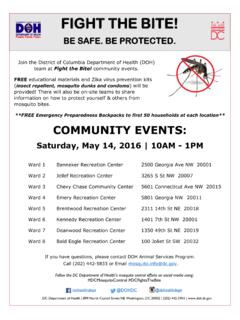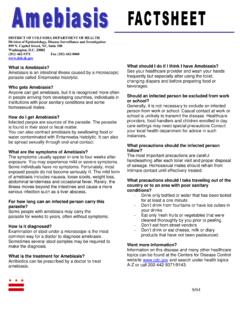Transcription of Medical Cannabis - | doh
1 Medical Cannabis Adverse Effects & Drug Interactions Adriane Fugh-Berman, MD Susan Wood, PhD Mikhail Kogan, MD Donald Abrams, MD Mary Lynn Mathre, RN, MSN, CARN Andrew Robie, MD Janani Raveendran, MEd Kofi Onumah, PharmD, RPh Rikin S. Mehta, PharmD, JD, LLM Shauna White, PharmD, RPh Jawara Kasimu-Graham, RPh 2 Presented by The slides will progress at their own pace. Do not attempt to speed up the video. The Post Test will only unlock after the entire video has been viewed. The video can be paused and resumed later. 3 Important Information Learning Objectives 4 Identify common adverse effects of Medical Cannabis use.
2 Identify contraindications to Medical Cannabis use. Describe Medical Cannabis drug interactions. Describe respiratory, cardiovascular, immune, neuropsychiatric, reproductive and other risks associated with Medical Cannabis use. Cannabis indica and Cannabis sativa are the best-known species. A product's chemical profile is more important than the strain of plant from which it originated. Products should be characterized by analytical chemistry - percentages of cannabinoids and terpenoids. Introduction to Cannabis 5 Cannabis , like all herbs, is a polypharmaceutical substance.
3 108 cannabinoids have been isolated (Hanu 2008). The Cannabis -derived cannabinoids of most therapeutic interest are THC and cannabidiol (CBD). Minor cannabinoids include cannabigerol, cannabichromene, and tetrahydrocannabivarin (a short-chain C19 homolog of THC). Terpenoids are common, often aromatic, organic compounds found in many plants. Terpenoids found in Cannabis include -caryophyllene, myrcene, limonene, and pinene. As many as 420 other constituents occur in the plant (Turner et al 1980). Compounds in Cannabis 6 (prescription cannabinoids, edibles, tinctures) Common Modes of Administration and Formulations 7 (herbal Cannabis , resin, concentrates) (lollipops, lozenges, nabiximols) (herbal Cannabis , resin, concentrates) Inhalation by smoking or vaporization Oral Oro-mucosal or sublingual Topical or Rectal Cannabis Safety Profile 8 Little is known about the safety of individual compounds.
4 Serious adverse effects are rare with Cannabis or its constituents. Marijuana has low to moderate dependence potential; the active dose is very far below the lethal dose (Gable et al 2006). (Adapted from Gable 2006) Common Adverse Effects 9 (Ashton 1999, Hall and Solowij 1998, Handbook on Cannabis 2015) Anxiety Decreased sperm count Sedation Slowed pupillary response to light Dizziness Altered sense of time Reduced tear flow Decreased eye blink rate Reddened eyes Dysphoria Ataxia Cough Dry mouth (and possibly associated caries and periodontitis) Bronchitis Changes in visual perceptions Reduced coordination Drug Interactions Cytochrome P450 Enzymes 10 THC and CBD are metabolized by CYP3A4 and CYP2C9 (Yamaori et al 2012, Watanabe et al 2007)
5 CYP3A4 inhibitors slightly increase THC levels. CYP3A4 inducers slightly decrease THC and CBD levels. CBD, but not THC, is metabolized by CYP2C19 (Stout and Cimino 2014). Drug Interactions Cytochrome P450 Enzymes 11 THC is a CYP1A2 inducer. Theoretically, THC can decrease serum concentrations of clozapine, duloxetine, naproxen, cyclobenzaprine, olanzapine, haloperidol, and chlorpromazine (Flockhart 2007, Watanabe et al 2007). CBD is a potent inhibitor of CYP3A4 and CYP2D6. As CYP3A4 metabolizes about a quarter of all drugs, CBD may increase serum concentrations of macrolides, calcium channel blockers, benzodiazepines, cyclosporine, sildenafil (and other PDE5 inhibitors), antihistamines, haloperidol, antiretrovirals, and some statins (atorvastatin and simvastatin, but not pravastatin or rosuvastatin).
6 CYP2D6 metabolizes many antidepressants, so CBD may increase serum concentrations of SSRIs, tricyclic antidepressants, antipsychotics, beta blockers and opioids (including codeine and oxycodone). Drug Interaction Studies 12 Warfarin THC and CBD increase warfarin levels (Yamaori et al 2012). Frequent Cannabis use has been associated with increased INR. Alcohol Alcohol may increase THC levels (Hartman 2015). Theophylline Smoked Cannabis can decrease theophylline levels (Stout and Cimino 2014). Indinavir or nelfinavir Smoked Cannabis had no effect (Abrams et al 2003).
7 Docetaxel or irinotecan Cannabis infusion (tea) had no effect (Engels et al 2007). Clobazam In children treated with CBD for epilepsy, CBD increased clobazam levels (Geffrey et al 2015). Drug Interaction Studies 13 CNS depressants Cannabis has additive CNS depressant effects with alcohol, barbiturates and benzodiazepines. In a small study, Cannabis did not have additive CNS effects when combined with opioids (Abrams et al 2011). Clinical Aspects Contraindications 14 Absolute contraindications Acute psychosis and other unstable psychiatric conditions Relative contraindications Severe cardiovascular, immunological, liver, or kidney disease, especially in acute illness Cannabis may exacerbate arrhythmia or a history of arrhythmias (Handbook on Cannabis 2015) Respiratory Effects Lung Function 15 A cross-sectional study using National Health and Nutrition Examination Survey (NHANES)
8 Data found that up to 20 joint-years* of marijuana use caused no adverse changes in lung function (Kempker et al 2015). The Coronary Artery Risk Development in Young Adults study, a cohort study of 5,115 adults, found no effect of occasional low marijuana use on pulmonary function (Pletcher et al 2012). In contrast, a cross-sectional Scottish study in 500 adults found evidence of impaired lung function in both Cannabis and tobacco smokers (MacLeod et al 2015). * A joint-year is the equivalent of smoking one joint or pipe bowl of marijuana for one year; it is the number of joints per day multiplied by the number of years of usage.
9 It is a way of standardizing use over time. Ten joint-years could describe one person who smoked a joint a day for 10 year or ten people who smoked a joint a day for one year. 2015 2012 2015 Respiratory Effects Smoked Cannabis 16 Smoked Cannabis is clearly associated with symptoms of bronchitis, which resolve after cessation of use (Tashkin 2013, Tashkin 2014). At least 200 compounds occur in Cannabis smoke (Spa racino et al 1990): these include carbon monoxide, acetaldehyde, ammonia, nitrosamines, and polycyclic aromatic hydrocarbons ( tars ). Combining tobacco and Cannabis appears to have synergistic adverse effects, increasing respiratory symptoms over tobacco use alone (MacLeod et al 2015, Bloom et al 1987).
10 Respiratory Effects Vaporization 17 A survey of 6,883 Cannabis users found that vaporizing, compared with smoking, causes fewer respiratory symptoms (coughing, wheezing, shortness of breath, mucus production) (Earlywine and Barnwell 2007). Analysis of vapor from a vaporizer recovered THC and smoke toxins; in contrast, Cannabis smoke from a pipe recovered THC and about 87% smoke toxins (Chemic Laboratories 2003). Vaporization, compared to smoking, generates less carbon monoxide (Abrams et al 2007). THC Respiratory Effects Chronic Obstructive Pulmonary Disease 18 Most studies have found that Cannabis is not associated with COPD.















